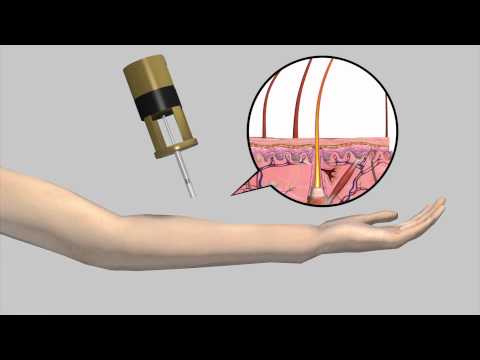Scientists develop device for needle-less injection
/Every year, approximately 16 million injections are administered to patients to deliver vital medications and vaccinations. However, new research from Massachusetts Institute of Technology (MIT) is promising to change the way we view injections by removing the need for needles.
The MIT team, led by Professor Ian Hunter, has developed a new way to inject medicine without a needle. The device uses a high-pressure jet to deliver medicine through the skin. A Lorentz-force actuator, which is comprised of a small, powerful magnet surrounded by a coil of wire, is connected to a piston which ejects the drug at a pressure and velocity strong enough to get through skin.
Although the skin is still punctured, similar to a needle system, the diameter of the stream is much smaller than a standard needle, about the quarter of the size or about the diameter of human hair. As a result the system is supposed to be less painful, feeling no worse than a mosquito bite.
Needle-free injection devices have been available since the 1930s, with similar devices being used for mass vaccination programs for over 50 years. The older devices relied on mechanical compression, such as compressed gas, to generate pressure to deliver medications through skin. As a result the set-up required made many of these devices cost-prohibitive outside of large programs. This new device however, is much smaller and could be available for personal use.
A personal needle-free system could be of great benefit to the hundreds of thousands of individuals who require daily injections of medications. For instance, those with insulin-dependent diabetes need multiple injections of insulin every day. Unfortunately, this means multiple painful needle sticks. A device of this nature could reduce the pain associated with therapy and improve compliance. Non-adherence to insulin regimens can have serious health consequences.
Another novel application of this device is its unique ability to vibrate powders into a state in which they act like a fluid. The ability to deliver powered medication could greatly aid in the distribution of vaccinations to remote locations. Liquid vaccinations tend to be more perishable, so the ability to use a powder could greatly increase the accessibility of vaccination programs.
This new, needle-less device is also adjustable unlike its predecessors. Typically, adults require a greater volume of medication then a small child or baby. Adult skin is thicker, so the medication needs to penetrate a greater distance. Since the force propelling the medication can be controlled, the amount of medicine delivered and the depth can be changed to accommodate different patients.
Additionally, the needle-less system would eliminate the need for needle disposal and the risk of accidental needle sticks. Each year, an estimated 385,000 needle sticks and other related injuries occur in health care workers.

